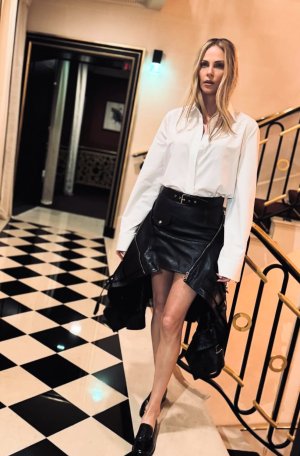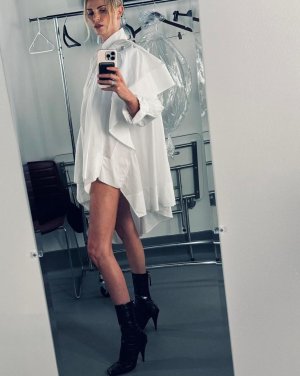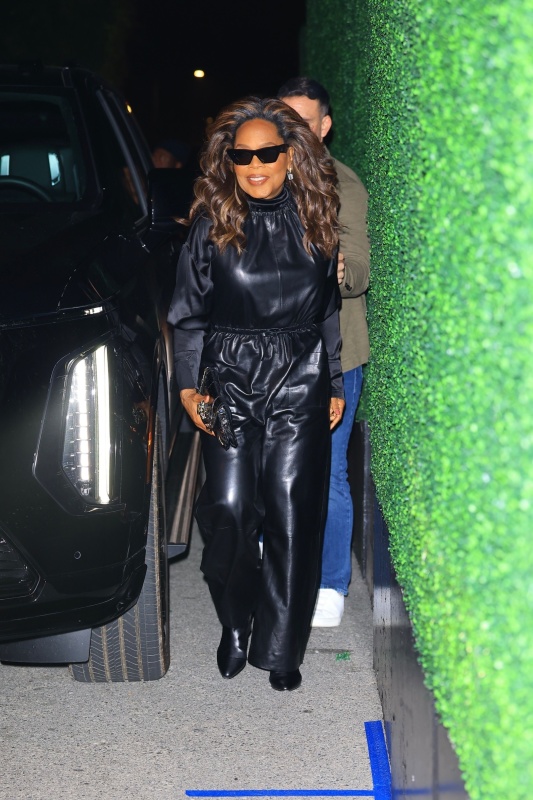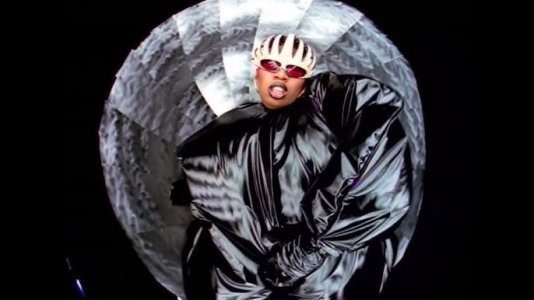You are using an out of date browser. It may not display this or other websites correctly.
You should upgrade or use an alternative browser.
You should upgrade or use an alternative browser.
Phoebe Philo - Designer
- Thread starter Cute
- Start date
MulletProof
Well-Known Member
- Joined
- Apr 18, 2004
- Messages
- 28,918
- Reaction score
- 8,029
I hate both looks on Jennifer tbh, I can't even choose which one is the worst, I want to say the first one with every trend under the sun compacted into one dress, or the second one with a 'modern' take on a basic but her stylist couldn't even bother to give her a good bra so instead of relaxed she looks uncomfortable and like when you just realised you've put on some weight and your own clothes feel weird and you've just doing mental equations on how to maneuver holding air in to look like you didn't. Or I could be projecting lol, and maybe she's just navigating fillers. Either way, both looks are horrid. Honestly, the only person that has elevated Phoebe Philo to aspirational heights is.. let's say it, Kendall Jenner. Her stylist is good with the 🧷s . I don't think every company out there would be making their own versions of Phoebe's caped leather bomber right now, if it wasn't for her.
ecnerretneerg
Well-Known Member
- Joined
- Jan 18, 2020
- Messages
- 338
- Reaction score
- 1,484
So articulate yet so diabolical 😂😂instead of relaxed she looks uncomfortable like when you just realised you've put on some weight and your own clothes feel weird and you've just doing mental equations on how to maneuver holding air in to look like you didn't
blackcherrified
Well-Known Member
- Joined
- Aug 6, 2011
- Messages
- 317
- Reaction score
- 416
Both looks are soo good. I am obsessed with her dress
It’s an interesting dress but pardon me for a minute I thought it was Bryce Dallas Howard I think this dress is a bit too “unpolished” for JLaw…?
RosesAreRed
Well-Known Member
- Joined
- May 2, 2020
- Messages
- 206
- Reaction score
- 290
She is not a Dior girl anymore? I thoght she can only wear Dior to events... Or is it a way to promote a fellow LVMH brand?It’s an interesting dress but pardon me for a minute I thought it was Bryce Dallas Howard I think this dress is a bit too “unpolished” for JLaw…?
Lola701
Well-Known Member
- Joined
- Oct 27, 2014
- Messages
- 14,128
- Reaction score
- 38,307
Ambassadors contract don’t mean that you have to only wear the brand you are contracted with.She is not a Dior girl anymore? I thoght she can only wear Dior to events... Or is it a way to promote a fellow LVMH brand?
She can wear whatever brand she wants except those that are in direct competition with Dior and that includes some brand in LVMH. She cannot wear Louis Vuitton but she can wear Givenchy or Kenzo (bless her soul).
Obviously, she cannot wear Prada, Hermes, Chanel, Gucci in public events either.
Phoebe Philo is an Independent brand. And I don’t think Phoebe does the celebrity thing so it was probably bought by her or her stylist.
rowjellies
Well-Known Member
- Joined
- Jun 25, 2024
- Messages
- 237
- Reaction score
- 703
JLaw is more fitting as an ambassador for The Row. She has been sort of an unofficial unpaid ambassador for them. She completely revamped her style in 2020 and helped popularize the brand during the pandemic with those street style photos. Of course, The Row doesn’t do celebrity ambassadors, so she stays on her Dior contract.JLaw is still with Dior, she was at PFW. I think she just "has" to wear it in big events. I'm sure if she attends the Oscars/SAG/GG she'll wear some custom Dior.
rowjellies
Well-Known Member
- Joined
- Jun 25, 2024
- Messages
- 237
- Reaction score
- 703
Not the case for Charlize and Givenchy. I wonder how many years left Charlize has in her Dior contract because she seems a huge fan of Sarah Burton for Givenchy, more suiting of her own style than JWA’s Loewe…She can wear whatever brand she wants except those that are in direct competition with Dior and that includes some brand in LVMH. She cannot wear Louis Vuitton but she can wear Givenchy or Kenzo (bless her soul).




RosesAreRed
Well-Known Member
- Joined
- May 2, 2020
- Messages
- 206
- Reaction score
- 290
Wow that white sute looks good on her!!! Maybe would be smart to switch such powerful ambasador to Givenchy!
Lola701
Well-Known Member
- Joined
- Oct 27, 2014
- Messages
- 14,128
- Reaction score
- 38,307
We agree on the question then. Charlize wears Givenchy, which is a LVMH brand but not a direct competition to Dior…Not the case for Charlize and Givenchy. I wonder how many years left Charlize has in her Dior contract because she seems a huge fan of Sarah Burton for Givenchy, more suiting of her own style than JWA’s Loewe…
View attachment 1422790View attachment 1422791View attachment 1422789View attachment 1422792
Givenchy is smaller than Loewe or Celine currently.
Her role as an ambassador has evolved but she is still linked on a long term to Dior.
hamburgers
Well-Known Member
- Joined
- Mar 25, 2025
- Messages
- 284
- Reaction score
- 1,224
If anyone is interested, some retailers (not just the usual gray market suspects) have quietly started discounts on Collection C including the bags/sunglasses with a little digging around you should be able to find them. But be warned some of the silhouettes are even taller and unwieldy than I remember from Celine as most people here already pointed out from the celeb appearances/lookbook shots.
PDFSD
Well-Known Member
- Joined
- Mar 27, 2024
- Messages
- 3,166
- Reaction score
- 11,402
both iconic agree
jeanclaude
Well-Known Member
- Joined
- Feb 12, 2012
- Messages
- 4,840
- Reaction score
- 14,393
Not sure if Oprah is wearing make-up or gaussian blur...
disco54
Well-Known Member
- Joined
- Apr 18, 2006
- Messages
- 5,053
- Reaction score
- 2,424
Beep beep who got the keys to jeep...vrrroooom lol
Monsieur Cristobal
Well-Known Member
- Joined
- Oct 27, 2024
- Messages
- 824
- Reaction score
- 3,696
She might look like the dominatrix in a David Cronenberg movie about mummification, but something is undeniable: Oprah really enjoys wearing PPhilo.
And that, in a landscape where so many celebrities are uncomfortably disguised under contract, is supercool.
PDFSD
Well-Known Member
- Joined
- Mar 27, 2024
- Messages
- 3,166
- Reaction score
- 11,402
pucknews
Phoebe’s Choice
Two years into her big experiment launching an independent brand, it’s clear that Phoebe Philo remains the visionary of her generation. At some point, though, Philo will have to decide how much she wants to integrate into the larger fashion system, which has long appropriated and profited off her ideas.
Since its 2023 launch, Philo has developed the company along a far different path than the one she walked at Céline for LVMH or, previously, Chloé for Richemont. Photo: Courtesy of Phoebe Philo
November 17, 2025
Last week, Phoebe Philo released another series of looks from Collection C, her third articulation of what it means to be a fashion brand in 2025. Imagery of the 16 pieces was shared widely across social media: model Caitlin Soetendal smiling with her teeth, wearing a napkin-collar sweater in sculpted cashmere; Sun Mizrahi’s hair arranged in a deep wide part, framed to show off silvery earrings made from a burst of organic-looking resin pearls; etcetera. They make abundantly clear how this drop, which was previewed by images that were originally released in March 2025, has already influenced other designers during the intervening months. After all, Philo is the leading visionary of her generation—the last real authority. She dictates how people dress, and other designers follow her rules consciously or not.
Since its 2023 launch, Philo has developed the company along a far different path than the one she walked at Céline for LVMH or, previously, Chloé for Richemont. The process was fraught, and success was initially in doubt amid mounting losses and some uncertain early operational decisions—the natural order of things for a startup. But many of the early principles that Philo and her husband-business partner, Max Wigram, laid out are still being honored. The drip feed of the product, inspired by the drop model, provides the requisite newness throughout the year. The focus on the owned and operated platform—now amplified by proliferation in select physical retail—is still viewed as the way to do things in this post-multichannel world. The brand retains momentum as it gathers data, all while positioning Philo as a true artist sending white smoke signals from the maison.
Then there’s the way the imagery and clothes have inspired others, from the analog style of the photography to the silhouettes, materials, and concepts. (Philo’s fluo-red will be the defining color of the 2020s.) Meanwhile, her and Wigram’s entanglement with the art and hospitality worlds—the brand’s sponsorship of Peter Doig’s “intoxicating” show at the Serpentine Galleries in London; Wigram’s purchase of the Three Horseshoes pub in Batcombe, Somerset; etcetera—all contribute to the feeling that the brand is ground zero for a particular fragment of culture, real or contrived.
All of that is for naught if the product doesn’t sell. And therein lies the good news: From what I am told, it is moving. The swingy Gig bag, first introduced in a larger, commuter-friendly style, has been shrunk down for car culture cities, where there’s no need to lug so much stuff around. The tinier version retails for $2,700, and has become a go-to for those wanting to cycle out their Margauxs and Andiamos. “When you see people like [stylist] Lotta Volkova carrying, it’s the beginning of it,” one industry executive said. “It’s happening.”
Similarly, the zip-back pants have become a staple in urban wardrobes in Paris, Milan, and London. In fact, you’ll observe them all over these days, and not just on women. At many of its major physical retail spaces—including Bergdorf Goodman and Galeries Lafayette—some 40 percent of the customers are men. (A rep for the brand did not respond to a request for comment regarding this intel.)
Phoebe Philo is a private company and shares figures only when it has to via the British registrar, which means the only available public financial information on the company is from 2023—a virtually prehistoric time, when it had been operating for just two months. But given the retail expansion (shop-in-shops in China, plus plans for a store on Mount Street in London) and the high-level distribution throughout Asia (not to mention the peak brand awareness among fashion consumers, and a robust private client business), I’d estimate (with help from industry sources with knowledge of these things) that the business is already generating $20 million-30 million in annual revenue. And I’d surmise that the business could double quickly, albeit less profitably, by scaling distribution and opening up stand-alone stores.
Think about it this way: It took Khaite nine years to get to $120 million a year in revenue, but a lot of that business has been concentrated in the U.S., with a chunk in Asia. Also, Khaite had zero name brand recognition or clientele when Cate Holstein founded the company. Philo had a running head start for all the aforementioned reasons, which facilitated a path to an investment from LVMH and the support of board member Delphine Arnault, providing a potential lever for scale and the wisdom to know how to deploy it.
Call of the Runway
Going forward, Phoebe Philo has two clear challenges it needs to rationalize. First, the company needs to sync its pricing in Europe with the U.S. market, where goods can cost nearly twice as much. Earlier this year, I bought a suit in Paris at Galeries Lafayette that cost roughly $3,000 total after I received my tax refund. If I had bought the same suit in New York at Bergdorf Goodman, it would have been close to $6,000. That’s easier said than done: Tariff hell and the rising cost of raw materials make it difficult for a brand like Phoebe Philo to harmonize prices across regions like Chanel or Hermès. But given the stressed-out retail environment stateside—the stores were dead this past weekend, and some brands are down 40 percent from last year at this time—offering value is increasingly important.You can see Philo attempting to do this to a certain extent already—the small (better) version of the Gig comes in at $2,700, while most other “It” bags start at $4,200. There are also some downright good deals in this latest drop. I reckon that the cluster sequin dress—a liquidy knit paired with a chunky, matte-sequin cropped top—which retails in the U.S. for $3,900, could cost more like $10,000. But that same dress retails for €2,800, or $3,200 at current exchange, in Europe. Factor in the tax refund and you are saving more than $1,000 if you buy it when you’re abroad.
Second, and more broadly, Philo and Wigram will have to decide how much they want to integrate into the larger fashion system, which has long appropriated and profited off her ideas. So far, from a marketing perspective, Philo has essentially done the opposite of what she did at Céline, where there was no social media and no online commerce. It was a very traditional way of disseminating content: She hosted a small, exclusive fashion show, and those images would travel around the internet. Long before The Row was hosting no-photo shows, Philo staged a private viewing for her last collection at Céline.
But people tend to make different decisions when their own capital is at stake: Just as she has moved back into wholesale—perhaps more quickly than she had imagined—one can’t help but wonder if it is worth Philo getting back into the runway game. From what I know about her, she is a person who needs a deadline, and while the demand for seasonal collections is strong enough now that she is forced to produce something, a runway show would organize her creativity.
Yes, yes, Philo has gone to great lengths to demonstrate that she is developing the brand by creating sheer desire, void of all the tricks most peers have to employ in order to get people to buy stuff. On the other hand, her ideas are so seminal and important to the work of other designers that it would be fun to see them within the context of the Fashion Week conversation again. And, most of all, scaling to the level where the business must consider tactics it once foreswore isn’t a bad thing. Some call it selling out, and yet that is also the goal.
nationalsalt
Well-Known Member
- Joined
- Apr 23, 2024
- Messages
- 204
- Reaction score
- 386
From what I know about her, she is a person who needs a deadline, and while the demand for seasonal collections is strong enough now that she is forced to produce something, a runway show would organize her creativity.
Yes, yes, Philo has gone to great lengths to demonstrate that she is developing the brand by creating sheer desire, void of all the tricks most peers have to employ in order to get people to buy stuff. On the other hand, her ideas are so seminal and important to the work of other designers that it would be fun to see them within the context of the Fashion Week conversation again. And, most of all, scaling to the level where the business must consider tactics it once foreswore isn’t a bad thing. Some call it selling out, and yet that is also the goal.
For London Fashion Week's sake, I hope she makes her catwalk return there and not in Paris...
Similar Threads
- Replies
- 7
- Views
- 3K
- Replies
- 97
- Views
- 29K
- Replies
- 9
- Views
- 3K
Users who are viewing this thread
Total: 2 (members: 0, guests: 2)
New Posts
-
-
-
-
Jonathan Anderson - Designer, Creative Director of JW Anderson & Christian Dior (11 Viewers)
- Latest: Frederic01
-


